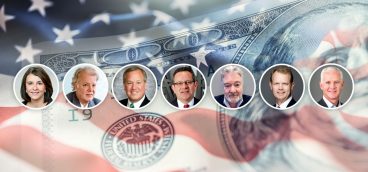Squeezing out the Investment Experts

The core problems with central bankers, which have led directly to the catastrophes of the Tech Bust, the Financial Crisis, the pathetically weak recovery from the Great Recession of 2008-09, and the near-destruction of the asset management business, are: groupthink, arising out of the fact that every central banker in the world went to the same universities (mainly MIT), have lived all their lives in academic communities, and have done nothing for three decades except read each others’ papers; and cluelessness, arising out of the fact that no central banker anywhere on the globe has ever had any experience working in the real world.
In other words, the Fed didn’t set out to destroy asset management. Fed governors weren’t venal or even stupid, they were simply clueless. When you possess the almost unlimited power that comes with almost unlimited balance sheets, you can’t just go off half-cocked trying bizarre ideas in the faint hope that one of them might work. You have to think of about secondary and tertiary and even quaternary effects.
But as a result of their lack of real-world experience, central bankers can’t think that deeply. They have no idea how their policies will affect non-central bankers and the lives and professions of ordinary people. There are simply many more things in heaven and earth than are dreamt of in their econometric philosophies.
When the Fed decided to pump up the stock market, they did so in complete ignorance of how asset management works. So—in case one of them should stumble onto this blog page—I’ll explain it to them.
While there are many ways to manage money, the gold standard is the value-oriented, bottom-up manager who pores endlessly over financial statements to find potentially interesting companies. The managers then get seriously to work, traveling hundreds of thousands of miles every year visiting the interesting companies, kicking the tires, talking with management teams, meeting with customers, suppliers, competitors. If they are also selling short, as in the hedge fund sector, they will also do this with companies that look lousy and are potential short sales.
This incredibly hard work gives professional money managers a vast advantage over ordinary amateur investors. Unfortunately, it doesn’t give them an advantage over most other professional investors, tens of thousands of whom are just as smart and work just as hard. What tends to set the superstars apart is the ability to create a coherent, focused investment culture in which skepticism is encouraged, risk is understood and respected, and incentives for long-term outperformance are aligned across the board.
A tiny fraction of the professional money managers in the world managed to create such cultures, almost all of them operating in boutique environments, rather than large corporate enterprises. These were the superstars of the money management world, and they provided their investors or principals with outstanding returns for decades.
Notice that these powerful investment cultures can look quite different on the surface. Compare Buffett and Munger at Berkshire Hathaway with the superb manager-of-managers program David Swensen built at Yale. Or compare those two with the remarkable internal management operation Jack Meyer assembled at Harvard. Different as those organizations appear to be, scratch the surface and you will find the same uncompromising commitments to excellence. (Incidentally, in 2005, under pressure from small-minded professors, Harvard forced Meyer out as its CIO. Since that time—12 years and counting—Harvard’s endowment has been a mess.)
But, suddenly, all this came to an end. Under Quantitative Easing (QE), none of that hard work, none of that keen intelligence, none of that remarkable investment culture mattered a whit. All stocks went up and they went up, as I’ve pointed out, indiscriminately. True, “growth” stocks wildly outperformed “value” stocks, but almost all the superstars were value investors.
For almost a decade, any retail investor who had the good sense to buy the Vanguard 500 Index Fund beat the best professional investors in the business. The retail crowd beat Harvard, Yale and Princeton. The dumber you were as an investor—no understanding of how money management worked, no clue about the virtues of diversification—the better your results.
Active management, a noble profession for 170 years, became a laughingstock, a fool’s game. Ordinary managers continued to play the game, often cheating by becoming closet indexers, but many of the best managers simply refused to play any longer. Partly, this was because they had spent decades building up terrific track records that were now being compromised by QE market-rigging. Mostly, though, these managers were principled people who told the simple truth: I can’t manage money effectively in a dishonest market and therefore I’m giving you your capital back.
If the money managers were being sabotaged, think of the poor asset allocators, who were subjected to a double-whammy. First, the great managers they had sweated blood to find now no longer existed. Managers could no longer produce great results and, in any event, many of the best had thrown in their hands. Great money management is one of the key arrows in the quiver of asset allocators as they try to keep their clients’ capital intact, but great money management has almost ceased to exist.
And, unfortunately, the asset allocators faced another problem, the one I alluded to above: diversification is at the core of their capital preservation strategies, but diversification no longer worked under QE. All the big central banks of the world were doing QE, of course. But the U.S. had the most powerful economy and the deepest, most efficient capital markets, and therefore U.S. stocks rose much faster than stocks in Britain, Europe, Japan, the emerging markets—than anywhere.
Without great money management to offer their clients, and without broad, sensible diversification to offer them, what exactly was it that asset allocators could do for the capital entrusted to them? Whether they toiled in-house at endowments or pension funds, or whether they toiled in free-standing firms, asset allocators faced an existential crisis and, unsurprisingly, a lot of them failed to survive it. Chief investment officer turnover soared, and many stand-alone firms such as investment consultants, wealth managers and even financial planners failed to survive the blow. They imploded, sold out, or morphed into multi-family offices that emphasized services other than investing.
Next week, I’ll step back and take a broader look at the carnage all this wreaked – not just on the world of asset management, but on everything.
Next up: Investing In a Rigged Market, Part IV





